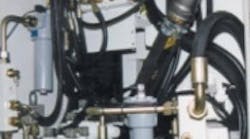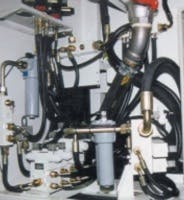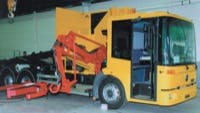OMB International, Brescia, Italy, has specialized in container transportation systems and disposal logistics for years. "In 1984, we introduced a system that has since gone into use all over the world, enabling containers to be loaded directly from trucks onto a train's flat car," says Pieter Doorenweerd, sales director of OMB's Translift products division.
Constant pressure to reduce operating costs in the early 1990s prompted disposal companies to find more cost-effective and efficient ways of disposing of waste from households and small businesses. In the mid-1990s Translift set new standards by applying its technology to disposal logistics. In close cooperation with disposal firms and suppliers, Translift developed a side-loading truck.
These vehicles have a hydraulically-powered gripper arm that empties residential trash containers and a hydraulic side lift for dumpsters at hotels, restaurants, and other commercial sites. The specialized vehicles are only used to collect the refuse and pack it into a standardized container. The containers can be transported to a landfill or incineration plant by ordinary flatbed trucks. This improves productivity because collection trucks forego the otherwise time-consuming task of hauling waste to a landfill, then traveling back to a collection site.
"The first delivery, back in 1995, consisted of 50 vehicles for Italy," adds Doorenweerd. "Our company has grown enormously since the days of the first automated collecting vehicle with a gripper arm," he adds. "Nowadays, the sideloader truck accounts for more than half of our sales." Doorenweerd explains that much of the company's success can be attributed to the vehicles' hydraulic system — more specially, the electrohydraulic control system.
Electrifying the situation
Translift's early systems used full hydraulic controls. However, environmental conditions — especially temperature extremes — can adversely affect hydraulic controls. Cold temperatures can cause sluggish operation, and extremely high temperatures can hinder controlability by making controls overly sensitive.
The side-loading principles demanded more consistent control, so electronic controls are used in favor of hydraulics. Each day, the gripper arm of the collecting vehicle empties as many as 2000 containers — a key component of its high productivity.
Other keys to the success of these machines are compact design and reliable operation. Compact design is required to provide multiple functions within a confined space. To achieve this, Translift called on Argo-Hytos to provide modular control blocks containing screw-in directional and proportional valves.
Reliable operation is attributed to strategic placement of high-pressure and suction filters to prevent malfunctions by keeping hydraulic filters clean. Of course, monitoring of fluid cleanliness and regular filter changes during scheduled downtime are key to maintaining reliable daily operation.
For more information call (419) 3536070 or visit www.argo-hytos.com.



